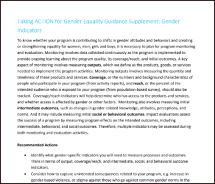Taking ACTION for Gender Equality Guidance Supplement: Gender Indicators
Impact evaluations assess the success of a program by measuring program effects on the intended outcomes, including intermediate, behavioral, and social outcomes. Therefore, multiple indicators may be assessed during both monitoring and evaluation activities.
Recommended Actions
- Identify what gender-specific indicators you will need to measure processes and outcomes. Think in terms of output, coverage/reach, and intermediate, social, and behavioral outcome indicators.
- Consider how to capture unintended consequences related to your program, e.g. increase in gender-based violence, or stigma against those who go against common gender norms in the community.
- Include indicators that address gender directly.
- At the same time, remember that many indicators will not specifically involve or mention gender, yet outcomes will be affected by the gender dynamics in the communities where the program is implemented. Therefore, it is essential to disaggregate indicators by sex, age, and other relevant demographic characteristics so that you can (1) measure differences by sex and other background characteristics at any given point in time and (2) identify what is associated with changes over time or if any trends are emerging. It will be important to assess whether those trends favor gender equality or maintain existing levels of inequality.
- Additionally, plan to disaggregate data by factors associated with marginalization, such as ethnicity, economic status, or other social determinants of health to understand constraints that Taking ACTION to increase Gender Equality certain groups may face relative to others, including ways in which they may face exclusion and marginalization when seeking to access health services or to participate in program activities.
Last modified: July 19, 2021
Language: English

